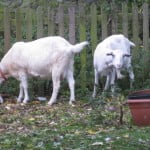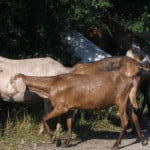Pet Advice Guides for Pet Owners
Beginners guide to goat-keeping
Goats live on average between 12 and 16 years. We’ve had them go on for much longer though. They have cloven hooves and an udder with two teats, ideal for rearing a couple of kids. It’s doubtful if more would survive in the wild. It’s a common misconception that goats eat anything. The truth is that they are the most fussy eaters imaginable and are very fastidious. They like to browse, wandering about and picking a few leaves here and there – goats like to eat deep rooted plants – trees, bushes, shrubs, herbs and anything twiggy – the rose garden especially. They have only one set of teeth, on their lower jaw, the top jaw has a hard palate, it’s still difficult to see how they can eat thistles and holly with such ease!
Goats should never be kept singly, they are herd animals with a strong sense of ‘family’ and they like to be in social group. There is always a pecking order though and one of them will be the ‘alpha’ female and they’ll all follow her lead. Female goats have no particular scent, they do not smell at all, except for the male goats who have a musky odour. The scent gland of a male is behind his horns and you can have it removed when he is disbudded, it will only take a second and then he will not smell either.
Goats nearly always grow horns and this is a problem if you are keeping them in fairly close quarters. The dominant goat is not averse to giving another member of the herd a ‘dutt’ with her horns if they are in a squabble over food or sleeping places. Unless you are keeping a herd of goats running out on a moor or large area, it is better to have them disbudded shortly after they are born. This is done by the vet who cauterizes the horn buds before they have had a chance to grow. Goats without horns are easy to handle and much friendlier with each other. This is a clannish species who like their own goat friends and sometimes resent newcomers. Goats invariably love their people though and this is one of the most affectionate of the animal species. The temperament of a goat is like that of a very loving dog the difference being that they don’t like you just for food, they like you just for being you.
One of the best ways to start in goatkeeping is to buy a couple of female kids. If they are being bottle reared you will have to find out the amount of milk and routine and then off you go – it’s like having a new baby, so make sure you have plenty of time. You can buy kid bottles and all milking utensils from farming supply shops. The bottles have to be kept very clean and sterilized every day. Or you could purchase a goatling, which is a young goat that hasn’t been mated, she’ll be in her first year of adult life and have left the baby bottles far behind. Young male goats are called bucklings.
It’s difficult to keep a male goat as a pet as all he’ll think about is being with a herd and mating. But you can get a couple of castrated male kids and rear them, they don’t develop any of the stud male characteristics and so long as they have been disbudded and de-musked will make interesting and affectionate companions.
Goats need shelter at all times – they also need freedom – exercise and fresh air. They are animals that are accustomed to walking and climbing, they like nothing better than to get up as high as possible. The problem is how to keep them in and they are masters at escape. (fencing article coming soon).
If you want the goat to keep you in milk then you will have to get her mated when she is eighteen months old. Goats come in season every three weeks in the winter months, apart from the Anglo Nubian breed who can come in season all year round. You’ll know your goat is on heat because she will be bleating non-stop. This is when you take her to the stud goat to be mated. There are goat clubs in most areas and they will tell you who has a stud goat. Or you can join the British Goat Society and they have lots of information. Getting your goat mated is without any difficulty, put her in with the stud goat and blink or you’ll miss it – there you are, she’s in kid. Watch out for her coming in season again in three weeks time (it’s called coming over) – if she does, you’ll have to take her back to be mated again. Goatkeepers don’t like to call their goats ‘nannies’ or ‘billies’ – they are females or does or stud males or bucks.
Goats are valuable animals, they can turn unusable scrub ground into delicious milk and with supplementary feeding will provide enough to rear their kids and some left over for the household. Goats are in kid for five months and usually manage their kidding without help. They need a clean shed with plenty of straw and some privacy. This is the one time when the goat will want to leave her friends and be on her own. Goats are wonderful mothers and we think it’s unkind to take the kids away when they are born. Some people do this because they don’t want them to suckle as they want the milk. We like to leave kids with mum so she can fuss and nuzzle them. If we want to bottle feed them we make a small pen in a corner and put them there so mum can still fuss them. Bottle fed kids are very tame, those reared on mum are less so.
Goats are affectionate companions who like to be with you and will go for walks just like a dog. They don’t like to be put on a lead though, they prefer to amble alongside so they eat as they go. Who is taking who for a walk? They are time consuming to care for but fit in very well with a self sufficiency/ gardening type of lifestyle. If you like independence and to provide your own food, then there is nothing better than to take up goat keeping. These gentle and intelligent animals will give you milk, cheese, butter and yoghurt – fresh and uncontaminated and without preservatives and additives. What could be better?


